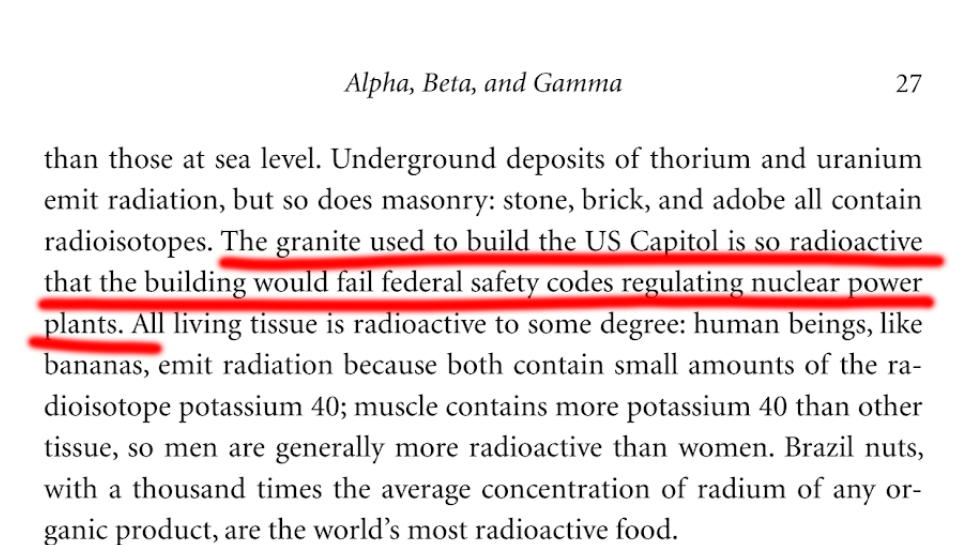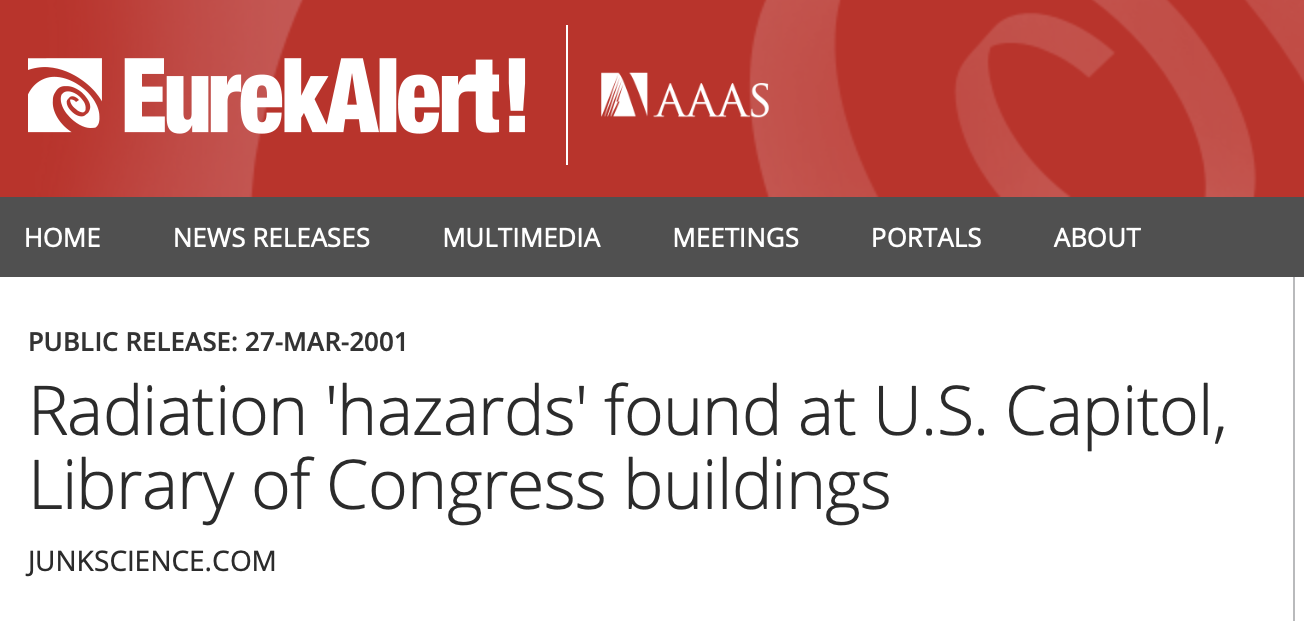Reading “Midnight in Chernobyl,” I came across this…


JunkScience.com readers will recall that we took a Geiger counter into the U.S. Capitol building to measure the radiation emitted by the building and statues.

The media release is here.
My related FoxNews.com column is here and below.
Our bust of radiation hysteria reached epic proportions:

Though “Midnight in Chernobyl” doesn’t source its assertion about the Capitol building, it is without question JunkScience.com.
###

Vice President Dick Cheney just announced that nuclear power should be part of our national energy strategy. But a little-noticed 11th-hour regulatory action by the Clinton administration may block the way.
To the rescue is Rhode Island founder Roger Williams or, at least, a statue of him located in the U.S. Capitol building. Williams, you see, spews far more radiation than the Environmental Protection Agency deems safe, and that raises some perplexing questions.
One controversy over nuclear power is what to do with the radioactive waste or “spent fuel” generated by nuke plants. A typical plant produces about 20 metric tons of spent fuel annually. Spent fuel produced over the last 40 years would, if stacked, cover an area the size of a football field to a depth of about five yards.
Spent fuel is being temporarily stored onsite in steel-lined, concrete pools. But plants are running out of pool space. By the end of 2006, about 60 plants will have no more pool space.
Alternative “dry” storage is possible, but is expensive and politically unpopular. So permanent disposal is sought.
Congress passed the Nuclear Waste Policy Act in 1982 directing the Department of Energy to find and build a disposal site for the spent fuel. The law requires customers of nuclear-generated electricity to pay for the storage facility. So far, ratepayers have contributed about $15 billion to the Nuclear Waste Fund.
The DOE wants to build a new disposal facility at Yucca Mountain, a site in the Nevada desert 100 miles from Las Vegas. The plan is to build a storage location about 800 feet underground by 2010.
Though the DOE is tasked with building the spent-fuel storage facility, the EPA is responsible for setting the environmental-safety standards with which the facility must comply.
Therein lies the rub. Some are using the EPA-issued standards as a way to achieve their special interests.
Anti-nuclear activists have long seen obstruction of efforts to dispose of spent fuel as a way to stop nuclear power. They hope that with nowhere to store spent fuel, nuke plants will be forced to shut down.
The Nevada congressional delegation, led by Sen. Harry Reid, doesn’t want its state stigmatized as a nuclear waste dump.
To this end, the activists and politicians have hijacked the EPA’s standard-setting process for Yucca Mountain. In August 1999, the EPA proposed to set unduly stringent standards for radiation exposures to the public from Yucca Mountain. Adding insult to injury, the DOE must ensure compliance with these standards for 10,000 years, according to the EPA proposal.
The standards are so stringent that, in the best case, they will only add greatly to the cost of Yucca Mountain without enhancing safety. In the worst case, they will disqualify Yucca Mountain as a disposal site — thereby wasting 14 years and $6 billion of the DOE’s efforts, not to mention casting a pall over the future of nuclear power.
On January 19, 2001, Clinton EPA Administrator Carol Browner moved to finalize the Yucca Mountain standards by submitting the regulations for White House signoff.
Sensing the absurdity of the EPA standards, Dr. Michael Gough and I commissioned radiation experts to measure radiation levels in the U.S. Capitol building and compare them with the proposed Yucca Mountain standards. The Capitol contains a great deal of granite and marble building materials that naturally emit the same type of radiation as spent fuel.
Our experts discovered that radiation dose rates at the Roger Williams statue, located between the Rotunda and Senate Chamber, are up to 65 times greater than what the EPA plans to allow at Yucca Mountain.
The radiation-dose rate at the Williams statue also is up to 550 percent higher than the dose rate received at the fenceline of a nuke plant, and about 13,000 times higher than the average annual radiation dose from worldwide nuclear-energy production.
Though our measurements were undertaken solely to illustrate the silliness of the EPA’s plans for Yucca Mountain, a worried constituent contacted a member of Congress about our report. The member requested the architect of the Capitol to investigate.
In an escalation of comedic proportion, the architect of the Capitol called in the U.S. Public Health Service. The PHS ended the alarm by reporting that radiation levels in the Capitol were not dangerous — which brings us back to Yucca Mountain.
If radiation dose rates up to 65 times higher than those planned for Yucca Mountain aren’t dangerous to Capitol building employees and visitors, what is the point of even more stringent standards for Yucca Mountain?
Many erroneously think the 1979 Three Mile Island incident doomed nuclear power in the U.S. Not so. A new Associated Press poll reports that 50 percent of Americans support nuclear power, and 56 percent of the supporters said they wouldn’t mind a nuclear plant within 10 miles of their own home.
Though support for nuclear power is rising, our national energy strategy will need to address the real threat to nuclear power: Anti-nuclear activists and politicians who have commandeered the Yucca Mountain standard-setting process.
Steven Milloy is a lawyer, biostatistician, adjunct scholar at the Cato Institute and publisher of JunkScience.com. He can be reached at milloy@cais.com.